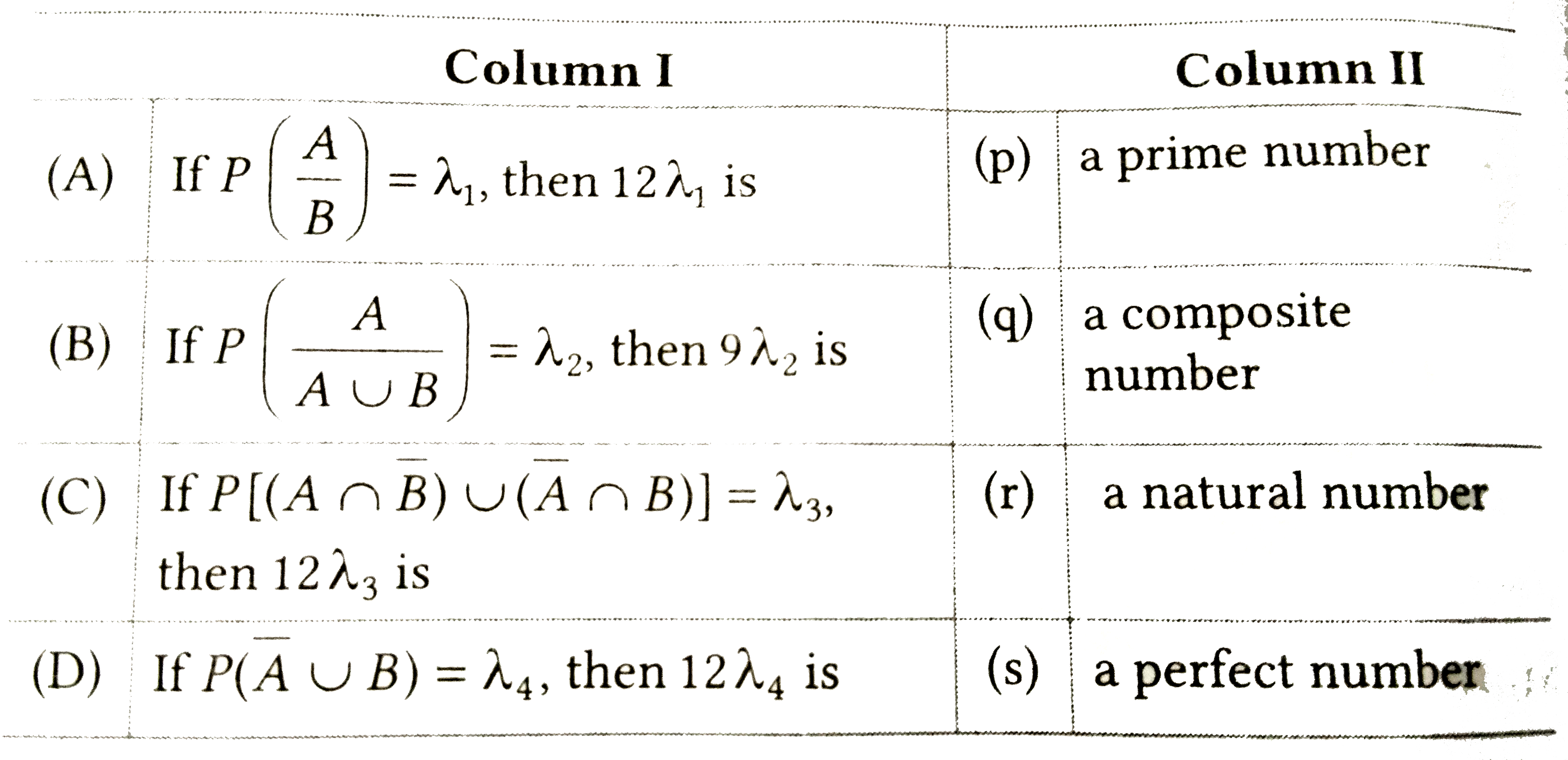If AandB are independent events of a random experiment such that P(A∩B)=16andP(¯¯¯A∩¯¯¯B)=13 then P(A)=
14
13
16
23
The correct Answer is:B
To solve the problem step by step, we will use the information given about the independent events A and B.
Step 1: Define the probabilities
Let P(A)=x and P(B)=y.
Step 2: Use the property of independent events
Since A and B are independent events, we have:
P(A∩B)=P(A)⋅P(B)=x⋅y
Given that P(A∩B)=16, we can write:
xy=16(1)
Step 3: Use the probability of complements
We also know:
P(¯¯¯¯A∩¯¯¯¯B)=P(¯¯¯¯A)⋅P(¯¯¯¯B)=(1−x)(1−y)
Given that P(¯¯¯¯A∩¯¯¯¯B)=13, we can write:
(1−x)(1−y)=13(2)
Step 4: Expand equation (2)
Expanding equation (2):
1−x−y+xy=13
Substituting xy=16 from equation (1):
1−x−y+16=13
Rearranging gives:
1−x−y=13−16
Calculating the right side:
13−16=26−16=16
Thus, we have:
1−x−y=16
Step 5: Rearranging to find x+y
Rearranging gives:
x+y=1−16=56(3)
Step 6: Solve the system of equations
Now we have two equations:
1. xy=16 (from equation (1))
2. x+y=56 (from equation (3))
We can express y in terms of x:
y=56−x
Substituting into equation (1):
x(56−x)=16
Expanding this gives:
56x−x2=16
Multiplying through by 6 to eliminate the fraction:
5x−6x2=1
Rearranging gives:
6x2−5x+1=0
Step 7: Solve the quadratic equation
Using the quadratic formula x=−b±√b2−4ac2a:
Here, a=6,b=−5,c=1:
x=−(−5)±√(−5)2−4⋅6⋅12⋅6
Calculating the discriminant:
25−24=1
Thus:
x=5±112
This gives us two possible values:
x=612=12andx=412=13
Step 8: Conclusion
Since P(A) must be a valid probability, we have:
P(A)=13orP(A)=12
From the context of the problem, the valid value for P(A) is:
P(A)=13
Let P(A)=x and P(B)=y.
Since A and B are independent events, we have:
P(A∩B)=P(A)⋅P(B)=x⋅y
Given that P(A∩B)=16, we can write:
xy=16(1)
We also know:
P(¯¯¯¯A∩¯¯¯¯B)=P(¯¯¯¯A)⋅P(¯¯¯¯B)=(1−x)(1−y)
Given that P(¯¯¯¯A∩¯¯¯¯B)=13, we can write:
(1−x)(1−y)=13(2)
Expanding equation (2):
1−x−y+xy=13
Substituting xy=16 from equation (1):
1−x−y+16=13
Rearranging gives:
1−x−y=13−16
Calculating the right side:
13−16=26−16=16
Thus, we have:
1−x−y=16
Rearranging gives:
x+y=1−16=56(3)
Now we have two equations:
1. xy=16 (from equation (1))
2. x+y=56 (from equation (3))
y=56−x
Substituting into equation (1):
x(56−x)=16
Expanding this gives:
56x−x2=16
Multiplying through by 6 to eliminate the fraction:
5x−6x2=1
Rearranging gives:
6x2−5x+1=0
Using the quadratic formula x=−b±√b2−4ac2a:
Here, a=6,b=−5,c=1:
x=−(−5)±√(−5)2−4⋅6⋅12⋅6
Calculating the discriminant:
25−24=1
Thus:
x=5±112
This gives us two possible values:
x=612=12andx=412=13
Since P(A) must be a valid probability, we have:
P(A)=13orP(A)=12
From the context of the problem, the valid value for P(A) is:
P(A)=13
Topper's Solved these Questions
- PROBABILITY BOOK - OBJECTIVE RD SHARMA ENGLISHCHAPTER - PROBABILITY EXERCISE - Section I - Solved Mcqs
126 Videos
- PROBABILITY BOOK - OBJECTIVE RD SHARMA ENGLISHCHAPTER - PROBABILITY EXERCISE - Section- II (Assertion -Reason Types MCQs)
15 Videos
- PERMUTATIONS AND COMBINATIONSBOOK - OBJECTIVE RD SHARMA ENGLISHCHAPTER - PERMUTATIONS AND COMBINATIONSEXERCISE - Chapter Test
60 Videos
- QUADRATIC EXPRESSIONS AND EQUATIONS BOOK - OBJECTIVE RD SHARMA ENGLISHCHAPTER - QUADRATIC EXPRESSIONS AND EQUATIONS EXERCISE - Chapter Test
50 Videos
Similar Questions
A and B are two independent events such that P(A) = 0.8 and P(A∩→B)=0.3 Find P(B)
View SolutionIf A and B are two independent events, such that P(A)=13andP(B)=14.

View SolutionA and B are events of an experiment such that 0<P(A), P(B)<1. If P(B')>P(A'), then
View SolutionIf A and B are independent events with P(A)=37 and P(B)=25 then find P(A'∩B')
View SolutionIf A and B are events of a random experiment such that P(A∩B)=45P(A'∩B')=710 and P(B)=25, then find the value of P(A).
View SolutionIf A and B are two independent events such that P(¯¯¯A∩B)=215andP(A∩¯¯¯B)=16 then P(B)=
View SolutionGiven two independent events A and B such that P(A)=0.3 and P(B)=0.6 . Find: P(A∩B)
View SolutionIf A and B are two independent events such that P(¯¯¯A∩B)=2/15 and P(A∩¯¯¯B)=1/6, then P(B), is
View SolutionIf A and B are two independent events such that P (A) =1/2,P(B)=1/5, then
View SolutionIf A and B are two independent events such that P(¯¯¯A∩B)=2/15 and P(A∩¯¯¯B)=1/6, then P(B) is
View Solution
